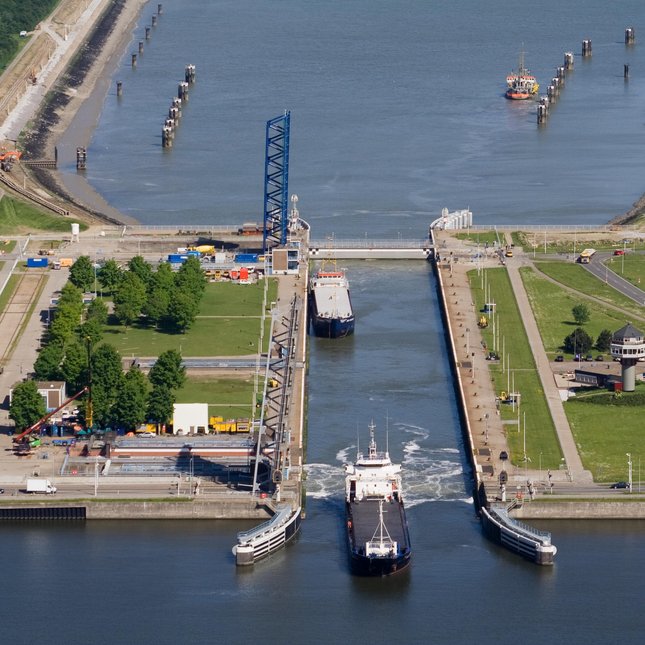Han Vogel, RWS and Tim Wilschut, TU/e PhD
We have to be thankful to Marco Polo who brought the engineering back to Europe from China centuries ago
The Netherlands is a country crisscrossed by waterways, a transport infrastructure that is an essential backbone of both industry and leisure. A key element in this infrastructure is the system of locks, 137 of which fall under the governance of Rijkswaterstaat (RWS) and are variously constructed and in different states of repair and maintenance. This presents a conundrum for RWS, the government department responsible for their management.

Marco Polo
“Many people tend to think that the lock system is a bit of Dutch invention, with all the canals and locks that are a familiar part of our landscape,” says Han Vogel of Rijkswaterstaat, “but actually we have to be thankful to Marco Polo who brought the engineering back to Europe from China centuries ago. And, of course, we are now exporting the expertise we have gained back to China,” he smiles. And it is expertise that is crucial in Rijkswaterstaat’s MultiWaterWerk (MWW) smart standardization initiative. This aims to tackle the problem of replacing, by the year 2040, fifty-two of the 137 locks, many of which were built during the last century and are either coming to the end of their lifetime or will soon be unable to cope with the increasing intensity of waterway traffic.
Collaborative multi-disciplinary approach
“We are faced by the problem of having to renovate a large proportion of our locks and to do this one by one is a highly inefficient process. So we need to standardize where possible,” Han explains. “I joined the team charged with tackling this problem. If you think about it, RWS is one big production line: we produce locks, just over one a year. But we need to standardize and innovate this production process. Having come from TNO, I was familiar with the collaborative, multidisciplinary approach we required and had good contacts with university research teams. So that’s where I started looking and came across an article by Professor Rooda who had written about standardizing production processes. We approached TU/e with the problem and arrived at the door of Pascal Etman where we discussed the approach we should take. That led us to appointing Tim and his exploratory investigation soon made it clear that two things had to be tackled together: first, the standardization of the components of the locks and their control engineering and, second, the standardization of the production processes of the locks.”

Product and the process
We first have to understand how the product is made, its components and behavior,” Tim Wilschut says. “We started by looking at the extent of the variations of the locks and by comparing all the different elements, we were able to come up with a chart, or matrix, that grouped the characteristics of the locks in clusters. What you then get is a lock family platform that you can use to organize the maintenance, renovation or replacements in future and thereby save on costs, time and effort. So, in that sense, we have tried to understand the diversity and shape it so that we have a better overview of the common core components that are primary candidates for standardization.” Furthermore, a common specifications language has been created, something that is essential since much of the work is carried out by a variety of contractors. “When we ask contractors to undertake work for us,” Han explains, “we want to be assured that they will follow the standardized process, too, and for that you need a standardized language.”
Speaking the same language
It is clear, too, that the collaboration partners have been speaking the same language together. “I started in September 2014 with the 9 month exploratory study in which we had intensive biweekly sessions,” Tim recalls. “After this 9 month period Rijkswaterstaat decided to finance two PhD’s at the High Tech Systems Center of which I am the first, and Martijn Goorden the second. As part of the TU/e investment project, TU/e financed two matching PhD positions. The first was filled by Ferdie Reijnen and the second position is still vacant. Being on the same wavelength really helped lay the foundation for this process. The regularity and intensity of the contact is not something I’ve seen too much among other research students around me. And what I think is also quite unique, is the way in which Rijkswaterstaat is open to all kinds of solutions. That gives us a great deal of freedom, and is really motivating. We have been able to reap the benefit of access to other areas of expertise from fellow research students of civil engineering and design. By combining disciplines we can deal with the problem much more effectively.
Into a more commercial arena
Not only is the collaboration helping RWS to take a significant step towards achieving its ambitions for standardizing lock design, building and maintenance throughout the Netherlands, and thereby lower lifecycle costs and improve the predictability of building costs and scheduling, but Bachelor and Master students are also benefiting from being able to work on these kinds of problems. It goes to show how effective collaboration between research, government and industry really can be a win-win-win situation all round. For his part, the MultiWaterWerk initiative has given Tim a bit of insight into where he sees his future. “I’m keen to take some of the techniques developed in this research into a more commercial arena,” says Tim. “Like the tooling I’m co-developing and want to bring into my own company start-up. There are already a couple of parties in the market who are enthusiastic, so the omens are good.”